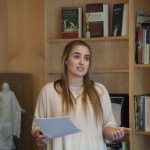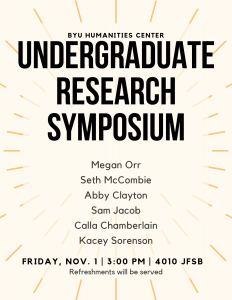The Humanities Center held its 7th annual Undergraduate Research Symposium (formerly called ORCA Symposium) on Friday, November 1st at 3:00 PM in 4010 JFSB. This year’s event featured undergraduate student research from around the college.
Megan Orr — A Room of Their Own: The Paradoxical Role of the Gynaikonitis in Women’s Oppression and Independence in Antiquity
 This research challenges the traditional narrative of women in antiquity as paralyzed under societal, economic, and political oppression. I explored this question via study of the gynaikonitis, or women’s quarters, of antiquity. The walls of the gynaikonitis are paradigmatic of women’s oppression, yet its unique properties of isolation and exclusive access provided women the unique luxury of a space all their own. The role of the gynaikonitis is paradoxical, and stands as the proving ground for my research. Both in spite of and due to the gynaikonitis, women in antiquity found economic independence, exploratory emotional expression, and in some cases, impressive political power that forever altered the course of history.
This research challenges the traditional narrative of women in antiquity as paralyzed under societal, economic, and political oppression. I explored this question via study of the gynaikonitis, or women’s quarters, of antiquity. The walls of the gynaikonitis are paradigmatic of women’s oppression, yet its unique properties of isolation and exclusive access provided women the unique luxury of a space all their own. The role of the gynaikonitis is paradoxical, and stands as the proving ground for my research. Both in spite of and due to the gynaikonitis, women in antiquity found economic independence, exploratory emotional expression, and in some cases, impressive political power that forever altered the course of history.
I conducted studies on-site at the ruins of Pompeii and Herculaneum in southern Italy to assess the physical attributes of the women’s quarters. This information illustrated the confines of the gynaikonitis, a framework from which one can assess the environmental psychology of the women within, as well as which independent and liberating activities were possible. I additionally surveyed artifacts from five of the greatest collections of antiquity in four European countries to formulate a comprehensive view of the world these women created. The endurance of the human spirit illustrated by these women under stringent oppression are historical proof of the following statement from Virginia Woolf:
“Women have sat indoors all these millions of years, so that by this time the very walls are permeated by their creative force, which has, indeed, so overcharged the capacity of bricks and mortar that it must needs harness itself to pens and brushes and business and politics.” ― Virginia Woolf, A Room of One’s Own (1929)
Seth McCombie — “Discovering the de-facto in Colloquial Egyptian Orthography”
 This research examines how the orthography of written Egyptian Colloquial Arabic (ECA) varies between different registers of formality. Since the inception of printing presses in the Middle East, nearly all Arabic printed material has been published in a formal register known as Modern Standard Arabic (MSA), which is rarely spoken by Egyptians. Meanwhile, the dialect of Arabic actually spoken in Egypt, (ECA), has enjoyed little attention in printed media and has traditionally been considered a debased form of the language. More recently, however, works written in ECA have appeared, including Bible translations produced by people who, like William Tyndale, hope to bring the Bible to Christians’ in their native tongue. Even so, there is little consistency in the orthography of these emerging works and no formal set of conventions exists. Thus, there is a need to identify what de-facto conventions may exist in the written language to inform publishing conventions and potentially lend legitimacy to the written form Arabic that is actually spoken in Egyptlan.
This research examines how the orthography of written Egyptian Colloquial Arabic (ECA) varies between different registers of formality. Since the inception of printing presses in the Middle East, nearly all Arabic printed material has been published in a formal register known as Modern Standard Arabic (MSA), which is rarely spoken by Egyptians. Meanwhile, the dialect of Arabic actually spoken in Egypt, (ECA), has enjoyed little attention in printed media and has traditionally been considered a debased form of the language. More recently, however, works written in ECA have appeared, including Bible translations produced by people who, like William Tyndale, hope to bring the Bible to Christians’ in their native tongue. Even so, there is little consistency in the orthography of these emerging works and no formal set of conventions exists. Thus, there is a need to identify what de-facto conventions may exist in the written language to inform publishing conventions and potentially lend legitimacy to the written form Arabic that is actually spoken in Egyptlan.
To discover any conventions and trends that may exist informally, I first identified 25 high-frequency morphemes and words which are most subject to change in ECA, as well as their variants. I then gathered three corpora totaling about four million words of ECA text from three different sources; Twitter, Blogs, and Wikipedia, representing three different levels of formality. After calculating the frequency of these 25 items and their variants in each corpus, obvious preferences towards certain spellings in certain registers became clear. The results of this research have valuable implications for Arabic publishing houses and those who translate works from MSA to ECA. Beyond the publishing field, however, this research also has the possibility to inform educational practices in the Middle East and underscore the value of instructing students in writing both MSA and its growing counterpart, ECA.
Abby Clayton — “The Greatest Showmen: P.T. Barnum, Charles Dickens, and the Fight for Shakespeare’s Legacy”
 Prior to its public auction in 1847, Shakespeare’s Birthplace—the home where he was born on Henley Street in Stratford-upon-Avon—was passed down through various private owners and their tenants who turned the property into an inn and a butcher shop. A mere sign indicated that “Shakespeare was born here.” By this point in time, Shakespeare’s literary influence permeated both Europe and America, but his status as a cultural icon was not strongly associated with the physical space of his home. However, this was about to change. In 1842, P.T. Barnum, the American showman of circus fame, was touring England with “The Greatest Show on Earth” when he went to visit Shakespeare’s home. Five years later, as he was always on the lookout for more “oddities” to add to his menagerie, the public auction of the Birthplace caught his interest, and he could not resist making an offer. This attempt by a foreign invader to “steal Shakespeare” inflamed the British public and sparked debates regarding the cultural ownership of the great playwright. Leading these debates was Charles Dickens, who initiated a series of events across England in an attempt to raise enough money to reclaim Shakespeare for the British people. This cultural interchange between Barnum and Dickens—the focus of my archival research completed during my internship in Stratford this past summer—reveals the way in which transatlantic celebrity was crucial to the formation of Shakespeare as a British heritage icon. Nearly 200 years later, as an American living in Stratford-upon-Avon, writing and conducting user-research to help the Shakespeare Birthplace Trust better appeal to a mass audience in England and beyond its borders, I could not help but realize I was reliving this same cultural phenomenon.
Prior to its public auction in 1847, Shakespeare’s Birthplace—the home where he was born on Henley Street in Stratford-upon-Avon—was passed down through various private owners and their tenants who turned the property into an inn and a butcher shop. A mere sign indicated that “Shakespeare was born here.” By this point in time, Shakespeare’s literary influence permeated both Europe and America, but his status as a cultural icon was not strongly associated with the physical space of his home. However, this was about to change. In 1842, P.T. Barnum, the American showman of circus fame, was touring England with “The Greatest Show on Earth” when he went to visit Shakespeare’s home. Five years later, as he was always on the lookout for more “oddities” to add to his menagerie, the public auction of the Birthplace caught his interest, and he could not resist making an offer. This attempt by a foreign invader to “steal Shakespeare” inflamed the British public and sparked debates regarding the cultural ownership of the great playwright. Leading these debates was Charles Dickens, who initiated a series of events across England in an attempt to raise enough money to reclaim Shakespeare for the British people. This cultural interchange between Barnum and Dickens—the focus of my archival research completed during my internship in Stratford this past summer—reveals the way in which transatlantic celebrity was crucial to the formation of Shakespeare as a British heritage icon. Nearly 200 years later, as an American living in Stratford-upon-Avon, writing and conducting user-research to help the Shakespeare Birthplace Trust better appeal to a mass audience in England and beyond its borders, I could not help but realize I was reliving this same cultural phenomenon.
Sam Jacob — “Intertextuality, Aesthetics, and the Digital: Rediscovering Chekhov in Early British Modernism”
 Intertextuality between Anton Chekhov and early modernist writers such as Virginia Woolf, Katherine Mansfield, James Joyce, and DH Lawrence is a recurrent topic in comparativist scholarship. However, due to a breadth of methodological and critical approaches, conclusions regarding Chekhov’s literary influence continues to puzzle and elude critics. This presentation shifts the exploration of Chekhovian intertextuality in the early modernist period (circa 1900-1925) away from the rigid concept of influence alone by introducing new intertextual links between Chekhov and British modernists through primary archival research, translation analysis, and a theoretical reconceptualization of intertextuality.
Intertextuality between Anton Chekhov and early modernist writers such as Virginia Woolf, Katherine Mansfield, James Joyce, and DH Lawrence is a recurrent topic in comparativist scholarship. However, due to a breadth of methodological and critical approaches, conclusions regarding Chekhov’s literary influence continues to puzzle and elude critics. This presentation shifts the exploration of Chekhovian intertextuality in the early modernist period (circa 1900-1925) away from the rigid concept of influence alone by introducing new intertextual links between Chekhov and British modernists through primary archival research, translation analysis, and a theoretical reconceptualization of intertextuality.
By applying current theory regarding literary aesthetics, postcritical hermeneutics, and digital textual analysis, I redefine intertextuality as multidirectional, showing that productive scholarly conversation and extra-textual creation can occur between texts that may not perfectly align along historical, contextual, or chronological lines. This theoretical methodology provides the foundation for interpreting the primary research of my presentation, wherein I have transcribed and digitized facsimiles of modernist short stories from their original periodicals. I then conduct comparative analyses of three of these stories alongside a Chekhov short story. These pairings bring both hallmark writers of the British modernist period and unstudied British authors into conversation with Chekhov’s texts, both in translation and in the original Russian. Some pairs challenge former claims of intertextual links between Chekhov and well-known British authors, such as Katherine Mansfield, and other pairs will identify newfound links between little-studied British writers and Chekhov himself. The readings blend traditional close reading, translation, and digital textual analysis, providing a more nuanced, multifaceted, and kaleidoscopic view of Chekhov’s influence on non-Russian authors. This examination of the unique and complex relationship between Chekhov and other modernist writers ultimately opens the door for more fruitful comparative study between texts of differing literary, national, and linguistic backgrounds.
Calla Chamberlain — “The Ross “Rusty” Butler Collection on Brazilian Protest Theater”
 For over 40 years, deep in the garage of former professor Ross E. Butler, Jr., a large box was nearly untouched by academic analysis. Performing research for his doctorate in the 1970s, Professor “Rusty” Butler traveled to Brazil and developed friendships with a number of leading writers and actors involved in the theater in Rio de Janeiro, many of whom he interviewed during the course of his research. Furthermore, when he was preparing to leave Brazil to return to the United States, several pleaded with him to take their works—including some that were unpublished and in manuscript form—out of the country in order to avoid government censors. While Professor Butler did publish one article based on his doctoral research, most of his original research materials remained untouched after he left academia to pursue other professions, thus leaving the voices of his old friends once again stifled and unheard. It was not until I began the process of organizing a special collection of those items that they finally came to light. I familiarized myself with the items in the collection and poured over them, searching for similarities across the materials so I could divide the collection into specific groupings. After meeting with a number of library specialists who taught me about finding aids and how to compile one, I logged all of the materials and their details and compiled the materials into files, leaving a finished, polished finding aid entitled The Ross “Rusty” Butler Collection on Brazilian Protest Theater. As far as the HumGrant is concerned, this project is complete. However, I hope to continue researching on my own. In fact, next week Dr. Nielson and I will interview Rusty, something I hope will yield a valuable addition to the collection.
For over 40 years, deep in the garage of former professor Ross E. Butler, Jr., a large box was nearly untouched by academic analysis. Performing research for his doctorate in the 1970s, Professor “Rusty” Butler traveled to Brazil and developed friendships with a number of leading writers and actors involved in the theater in Rio de Janeiro, many of whom he interviewed during the course of his research. Furthermore, when he was preparing to leave Brazil to return to the United States, several pleaded with him to take their works—including some that were unpublished and in manuscript form—out of the country in order to avoid government censors. While Professor Butler did publish one article based on his doctoral research, most of his original research materials remained untouched after he left academia to pursue other professions, thus leaving the voices of his old friends once again stifled and unheard. It was not until I began the process of organizing a special collection of those items that they finally came to light. I familiarized myself with the items in the collection and poured over them, searching for similarities across the materials so I could divide the collection into specific groupings. After meeting with a number of library specialists who taught me about finding aids and how to compile one, I logged all of the materials and their details and compiled the materials into files, leaving a finished, polished finding aid entitled The Ross “Rusty” Butler Collection on Brazilian Protest Theater. As far as the HumGrant is concerned, this project is complete. However, I hope to continue researching on my own. In fact, next week Dr. Nielson and I will interview Rusty, something I hope will yield a valuable addition to the collection.
Kacey Sorenson — “Re-colonizing the Caribbean: Climate Change, Derek Walcott’s ‘Omeros’ and Niche Modeling”
 Colonization imprinted the Caribbean environment with naturalized and invasive plant species from around the world. Now, climate change is causing a second reshuffling of plants in the Caribbean, creating new tensions and competition between native, naturalized, and invasive species. This tension is well established in the poetry of Derek Walcott, a native Saint Lucian and a Nobel Laureate considered one of the greatest poets of the Caribbean and the twentieth century. His work focuses on the interaction between environmental and human history, and is one of the first to cite the impending impact of climate change on the postcolonial environment of the Caribbean (Handley). My central question was whether climate change, with its shadow of a second colonial invasion, will favor invasive species over Caribbean natives. To decipher an answer, I worked the Biology department to record species mentioned in Walcott’s epic poem, Omeros, categorize them as invasive or native, predict, using a well-developed niche-modeling program, the long-term effects of climate change on these Caribbean species (Higgins et. al). After, I worked with Dr. Handley to carefully analyze themes in the poem itself, focusing specifically on species’ symbolic significance in the text. This interdisciplinary approach is significant for the ways it bridges the humanities and empirical data by predicting long-term environmental effects of colonization. By collecting data relevant to Caribbean plant species through the niche modeling program and then by confirming it through analysis of the text itself, we expanded through empirical evidence the current literary dialogue surrounding colonization’s long-term effects on more than just the people and cultures that were colonized. By using physiological niche modeling coupled with ensemble climate change forecasts, we have ultimately made strides in predicting the effects of slow violence on the environment of this colonized area of the world (Higgins et al).
Colonization imprinted the Caribbean environment with naturalized and invasive plant species from around the world. Now, climate change is causing a second reshuffling of plants in the Caribbean, creating new tensions and competition between native, naturalized, and invasive species. This tension is well established in the poetry of Derek Walcott, a native Saint Lucian and a Nobel Laureate considered one of the greatest poets of the Caribbean and the twentieth century. His work focuses on the interaction between environmental and human history, and is one of the first to cite the impending impact of climate change on the postcolonial environment of the Caribbean (Handley). My central question was whether climate change, with its shadow of a second colonial invasion, will favor invasive species over Caribbean natives. To decipher an answer, I worked the Biology department to record species mentioned in Walcott’s epic poem, Omeros, categorize them as invasive or native, predict, using a well-developed niche-modeling program, the long-term effects of climate change on these Caribbean species (Higgins et. al). After, I worked with Dr. Handley to carefully analyze themes in the poem itself, focusing specifically on species’ symbolic significance in the text. This interdisciplinary approach is significant for the ways it bridges the humanities and empirical data by predicting long-term environmental effects of colonization. By collecting data relevant to Caribbean plant species through the niche modeling program and then by confirming it through analysis of the text itself, we expanded through empirical evidence the current literary dialogue surrounding colonization’s long-term effects on more than just the people and cultures that were colonized. By using physiological niche modeling coupled with ensemble climate change forecasts, we have ultimately made strides in predicting the effects of slow violence on the environment of this colonized area of the world (Higgins et al).







